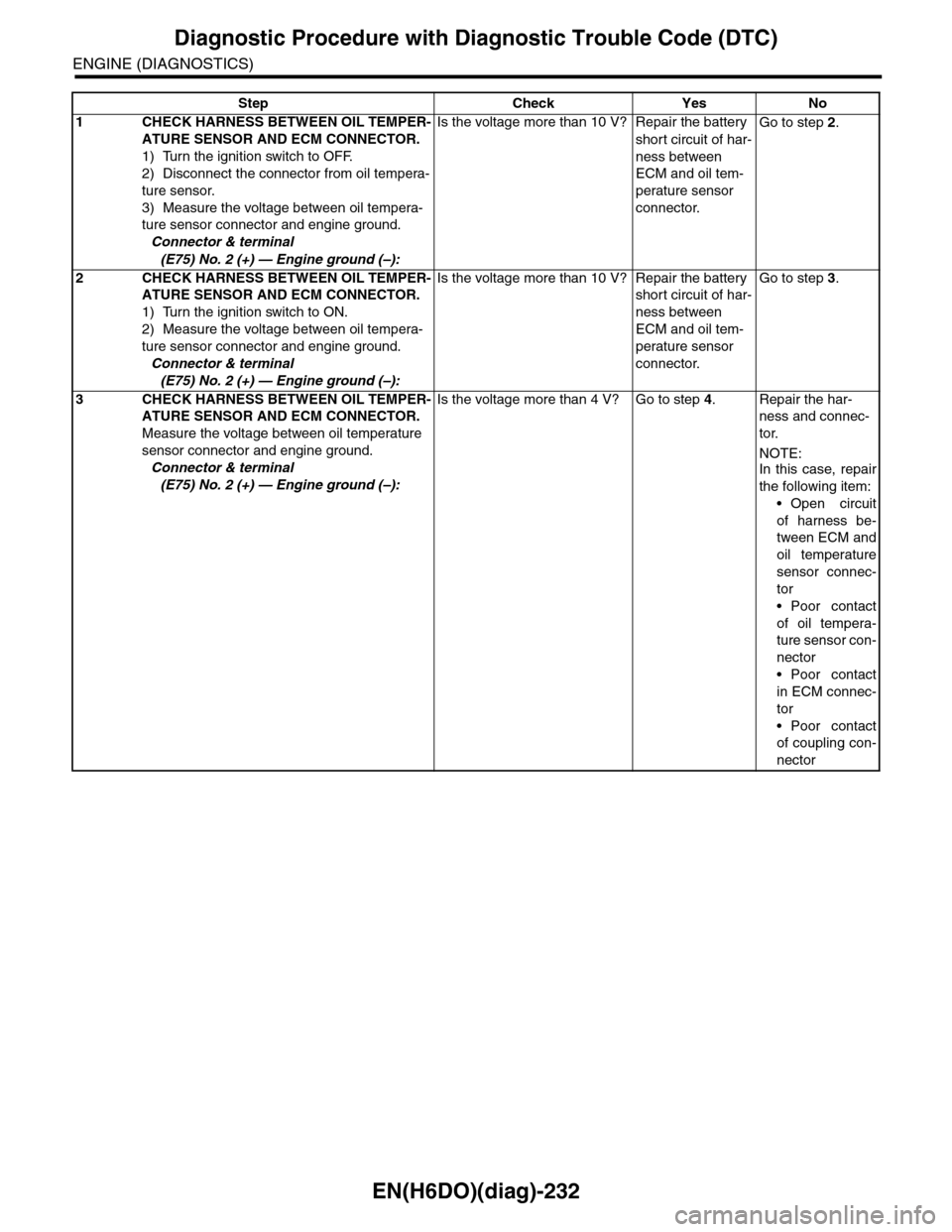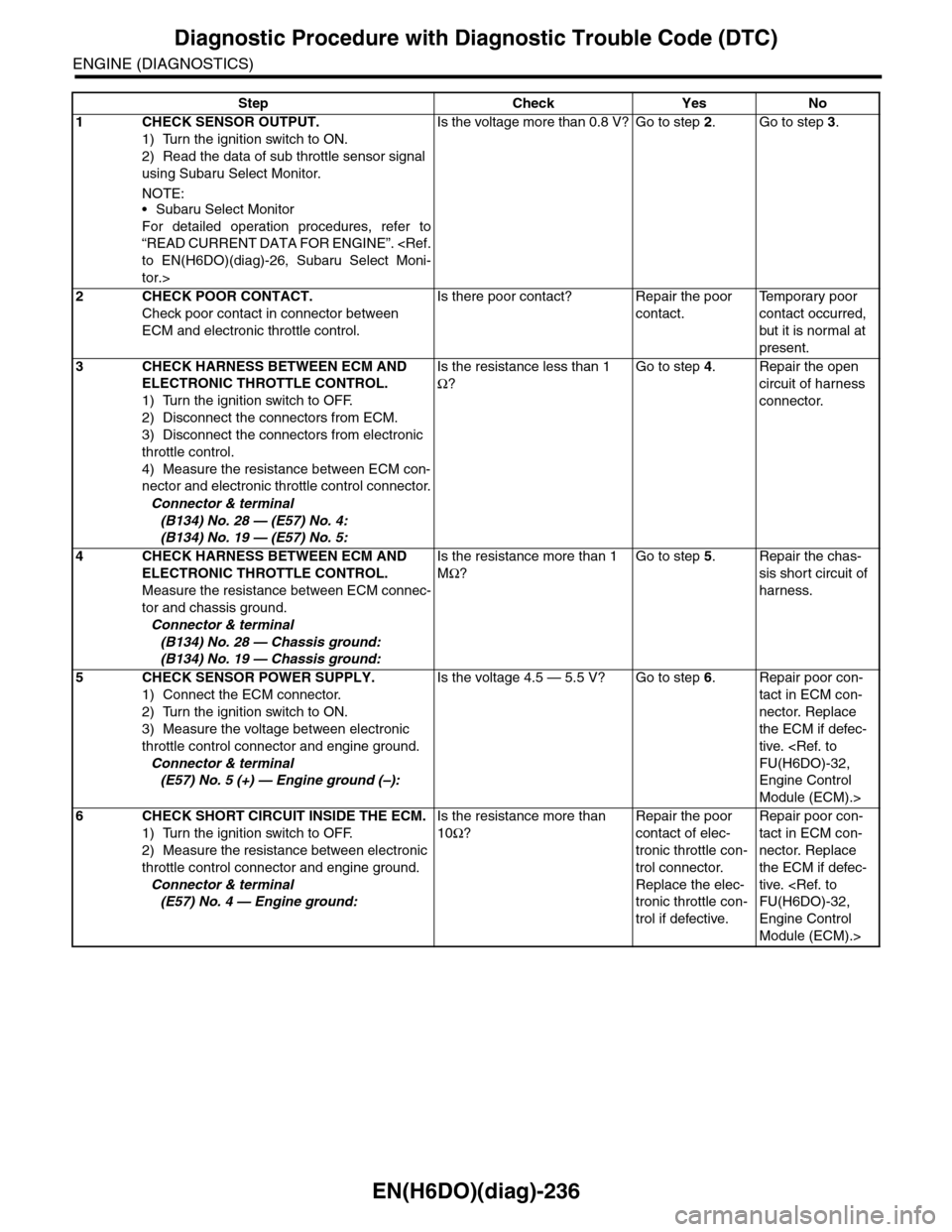Page 1390 of 2453
EN(H6DO)(diag)-229
Diagnostic Procedure with Diagnostic Trouble Code (DTC)
ENGINE (DIAGNOSTICS)
BI: DTC P0197 ENGINE OIL TEMPERATURE SENSOR CIRCUIT LOW
DTC DETECTING CONDITION:
•Immediately at fault recognition
•GENERAL DESCRIPTION
CIRCUIT LOW, Diagnostic Trouble Code (DTC) Detecting Criteria.>
TROUBLE SYMPTOM:
•Hard to start
•Erroneous idling
•Poor driving performance
CAUTION:
After repair or replacement of faulty parts, perform Clear Memory Mode
OPERATION, Clear Memory Mode.> and Inspection Mode
Inspection Mode.>.
WIRING DIAGRAM:
EN-03662
E75
E2
B21
B134 ECM
1
19
29
E1
B20
2
3
23
E75
12
B20
1234567891011 121314 15 16
B21
123412131415567816171819910 1120212223 24 25 2627 28 29 3031 32 33
3534 37363938 41404342 4445 47464948 51505352 54
OILTEMPERATURESENSOR
B134
85610 11 12 13 14 157213416
3019 20 2228 29
91718252123 24323126 2733 34
Page 1391 of 2453
EN(H6DO)(diag)-230
Diagnostic Procedure with Diagnostic Trouble Code (DTC)
ENGINE (DIAGNOSTICS)
Step Check Yes No
1CHECK HARNESS BETWEEN OIL TEMPER-
ATURE SENSOR AND ECM CONNECTOR.
1) Disconnect the ECM connector and oil tem-
perature sensor connector.
2) Measure the resistance of harness
between oil temperature sensor connector and
engine ground.
Connector & terminal
(B134) No. 23 — Engine ground:
(B134) No. 29 — Engine ground:
Is the resistance more than 1
MΩ?
Go to step 2.Repair the ground
short circuit
between ECM and
oil temperature
sensor connector.
2CHECK POOR CONTACT.
Check poor contact of oil temperature sensor
connector.
Is there poor contact in oil tem-
perature sensor connector?
Repair the poor
contact.
Replace the oil
temperature sen-
sor.
FU(H6DO)-27, Oil
Te m p e r a t u r e S e n -
sor.>
Page 1392 of 2453
EN(H6DO)(diag)-231
Diagnostic Procedure with Diagnostic Trouble Code (DTC)
ENGINE (DIAGNOSTICS)
BJ:DTC P0198 ENGINE OIL TEMPERATURE SENSOR CIRCUIT HIGH
DTC DETECTING CONDITION:
•Immediately at fault recognition
•GENERAL DESCRIPTION
CIRCUIT HIGH, Diagnostic Trouble Code (DTC) Detecting Criteria.>
TROUBLE SYMPTOM:
•Hard to start
•Erroneous idling
•Poor driving performance
CAUTION:
After repair or replacement of faulty parts, perform Clear Memory Mode
OPERATION, Clear Memory Mode.> and Inspection Mode
Inspection Mode.>.
WIRING DIAGRAM:
EN-03662
E75
E2
B21
B134 ECM
1
19
29
E1
B20
2
3
23
E75
12
B20
1234567891011 121314 15 16
B21
123412131415567816171819910 1120212223 24 25 2627 28 29 3031 32 33
3534 37363938 41404342 4445 47464948 51505352 54
OILTEMPERATURESENSOR
B134
85610 11 12 13 14 157213416
3019 20 2228 29
91718252123 24323126 2733 34
Page 1393 of 2453

EN(H6DO)(diag)-232
Diagnostic Procedure with Diagnostic Trouble Code (DTC)
ENGINE (DIAGNOSTICS)
Step Check Yes No
1CHECK HARNESS BETWEEN OIL TEMPER-
ATURE SENSOR AND ECM CONNECTOR.
1) Turn the ignition switch to OFF.
2) Disconnect the connector from oil tempera-
ture sensor.
3) Measure the voltage between oil tempera-
ture sensor connector and engine ground.
Connector & terminal
(E75) No. 2 (+) — Engine ground (–):
Is the voltage more than 10 V? Repair the battery
short circuit of har-
ness between
ECM and oil tem-
perature sensor
connector.
Go to step 2.
2CHECK HARNESS BETWEEN OIL TEMPER-
ATURE SENSOR AND ECM CONNECTOR.
1) Turn the ignition switch to ON.
2) Measure the voltage between oil tempera-
ture sensor connector and engine ground.
Connector & terminal
(E75) No. 2 (+) — Engine ground (–):
Is the voltage more than 10 V? Repair the battery
short circuit of har-
ness between
ECM and oil tem-
perature sensor
connector.
Go to step 3.
3CHECK HARNESS BETWEEN OIL TEMPER-
ATURE SENSOR AND ECM CONNECTOR.
Measure the voltage between oil temperature
sensor connector and engine ground.
Connector & terminal
(E75) No. 2 (+) — Engine ground (–):
Is the voltage more than 4 V? Go to step 4.Repair the har-
ness and connec-
tor.
NOTE:
In this case, repair
the following item:
•Open circuit
of harness be-
tween ECM and
oil temperature
sensor connec-
tor
•Poor contact
of oil tempera-
ture sensor con-
nector
•Poor contact
in ECM connec-
tor
•Poor contact
of coupling con-
nector
Page 1394 of 2453
EN(H6DO)(diag)-233
Diagnostic Procedure with Diagnostic Trouble Code (DTC)
ENGINE (DIAGNOSTICS)
4CHECK HARNESS BETWEEN OIL TEMPER-
ATURE SENSOR AND ECM CONNECTOR.
1) Turn the ignition switch to OFF.
2) Measure the resistance of harness
between oil temperature sensor connector and
engine ground.
Connector & terminal
(E75) No. 1 — Engine ground:
Is the resistance less than 5
Ω?
Replace the oil
temperature sen-
sor.
FU(H6DO)-27, Oil
Te m p e r a t u r e S e n -
sor.>
Repair the har-
ness and connec-
tor.
NOTE:In this case, repair
the following item:
•Open circuit
of harness be-
tween ECM and
oil temperature
sensor connec-
tor
•Poor contact
of oil tempera-
ture sensor con-
nector
•Poor contact
in ECM connec-
tor
•Poor contact
of coupling con-
nector
•Poor contact
of joint connec-
tor
Step Check Yes No
Page 1395 of 2453
EN(H6DO)(diag)-234
Diagnostic Procedure with Diagnostic Trouble Code (DTC)
ENGINE (DIAGNOSTICS)
BK:DTC P0222 THROTTLE/PEDAL POSITION SENSOR/SWITCH “B” CIRCUIT
LOW INPUT
DTC DETECTING CONDITION:
•Immediately at fault recognition
•GENERAL DESCRIPTION
SOR/SWITCH “B” CIRCUIT LOW INPUT, Diagnostic Trouble Code (DTC) Detecting Criteria.>
TROUBLE SYMPTOM:
•Erroneous idling
•Poor driving performance
•Engine stalls.
Page 1397 of 2453

EN(H6DO)(diag)-236
Diagnostic Procedure with Diagnostic Trouble Code (DTC)
ENGINE (DIAGNOSTICS)
Step Check Yes No
1CHECK SENSOR OUTPUT.
1) Turn the ignition switch to ON.
2) Read the data of sub throttle sensor signal
using Subaru Select Monitor.
NOTE:•Subaru Select Monitor
For detailed operation procedures, refer to
“READ CURRENT DATA FOR ENGINE”.
to EN(H6DO)(diag)-26, Subaru Select Moni-
tor.>
Is the voltage more than 0.8 V? Go to step 2.Go to step 3.
2CHECK POOR CONTACT.
Check poor contact in connector between
ECM and electronic throttle control.
Is there poor contact? Repair the poor
contact.
Te m p o r a r y p o o r
contact occurred,
but it is normal at
present.
3CHECK HARNESS BETWEEN ECM AND
ELECTRONIC THROTTLE CONTROL.
1) Turn the ignition switch to OFF.
2) Disconnect the connectors from ECM.
3) Disconnect the connectors from electronic
throttle control.
4) Measure the resistance between ECM con-
nector and electronic throttle control connector.
Connector & terminal
(B134) No. 28 — (E57) No. 4:
(B134) No. 19 — (E57) No. 5:
Is the resistance less than 1
Ω?
Go to step 4.Repair the open
circuit of harness
connector.
4CHECK HARNESS BETWEEN ECM AND
ELECTRONIC THROTTLE CONTROL.
Measure the resistance between ECM connec-
tor and chassis ground.
Connector & terminal
(B134) No. 28 — Chassis ground:
(B134) No. 19 — Chassis ground:
Is the resistance more than 1
MΩ?
Go to step 5.Repair the chas-
sis short circuit of
harness.
5CHECK SENSOR POWER SUPPLY.
1) Connect the ECM connector.
2) Turn the ignition switch to ON.
3) Measure the voltage between electronic
throttle control connector and engine ground.
Connector & terminal
(E57) No. 5 (+) — Engine ground (–):
Is the voltage 4.5 — 5.5 V? Go to step 6.Repair poor con-
tact in ECM con-
nector. Replace
the ECM if defec-
tive.
FU(H6DO)-32,
Engine Control
Module (ECM).>
6CHECK SHORT CIRCUIT INSIDE THE ECM.
1) Turn the ignition switch to OFF.
2) Measure the resistance between electronic
throttle control connector and engine ground.
Connector & terminal
(E57) No. 4 — Engine ground:
Is the resistance more than
10Ω?
Repair the poor
contact of elec-
tronic throttle con-
trol connector.
Replace the elec-
tronic throttle con-
trol if defective.
Repair poor con-
tact in ECM con-
nector. Replace
the ECM if defec-
tive.
FU(H6DO)-32,
Engine Control
Module (ECM).>
Page 1398 of 2453
EN(H6DO)(diag)-237
Diagnostic Procedure with Diagnostic Trouble Code (DTC)
ENGINE (DIAGNOSTICS)
BL:DTC P0223 THROTTLE/PEDAL POSITION SENSOR/SWITCH “B” CIRCUIT
HIGH INPUT
DTC DETECTING CONDITION:
•Immediately at fault recognition
•GENERAL DESCRIPTION
SOR/SWITCH “B” CIRCUIT HIGH INPUT, Diagnostic Trouble Code (DTC) Detecting Criteria.>
TROUBLE SYMPTOM:
•Erroneous idling
•Poor driving performance
•Engine stalls.